fuel cap OLDSMOBILE BRAVADA 1998 Owners Manual
[x] Cancel search | Manufacturer: OLDSMOBILE, Model Year: 1998, Model line: BRAVADA, Model: OLDSMOBILE BRAVADA 1998Pages: 380, PDF Size: 19.2 MB
Page 123 of 380
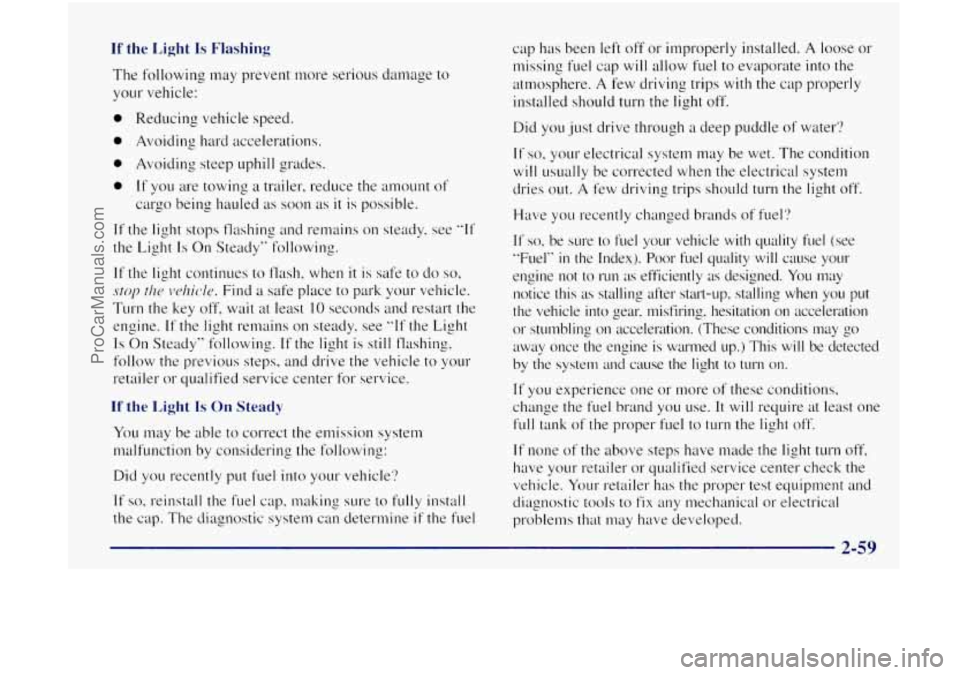
If the Light Is Flashing
The following may prevent more serious damage to
your vehicle:
0 Reducing vehicle speed.
0 Avoiding hard accelerations.
0 Avoiding steep uphill grades.
0 If you are towing a trailer, reduce the amount of
cargo being hauled
as soon as it is possible.
If the light
stops flashing and remains on steady, see "If
the Light
Is On Steady'. following.
If the light continues to flash, when it is safe to clo so,
stop the vel?icle. Find a safe place to park your vehicle.
Turn the key off, wait at least 10 seconds and restart the
engine.
If the light remains on steady, see "If the Light
Is On Steady" following. If the light is still .flashing,
follow the previous steps, and drive the vehicle to your
retailer or qualified service center for service.
If the Light Is On Steady
YOLI may be able to correct the emission system
malfunction by considering
the following:
Did you recently
put fuel into your vehicle'?
If so, reinstall the fuel cap, making sure to fully install
the cap. The diagnostic system can determine
if the fuel cap
has been left off or improperly installed.
A loose or
missing fuel cap
will allow fuel to evaporate into the
atmosphere.
A few driving trips with the cap properly
installed should turn the light off.
Did you just drive through a deep puddle
of water?
If so, your electrical system may be wet. The condition
will usually be corrected when the electrical system
dries out. A few driving trips should
turn the light off.
Have you recently changed brands
of fuel?
If so, be s~~re to file1 your vehicle with quality fuel (see
"Fuel"
in the Index). Poor fuel quality will cause your
engine not
to run as efficiently as designed. You may
notice
this as stalling after start-up, stalling when you put
the vehicle into gear, misfiring, hesitation on acceleration
or stumbling on acceleration. (These conditions may go
away once the engine is warmed up.) This
will be detected
by the system and cause the light to turn
on.
If YOLI experience one or more of these conditions,
change the fuel brand
yo^^ use. It will require at least one
full tank of the proper fuel to turn the light off.
If none of the above steps have made the light turn off,
have your retailer or qualified service center check the
vehicle. Your retailer has the proper test equipment and
diagnostic tools
to fix any mechanical or electrical
problems that may have developed.
ProCarManuals.com
Page 127 of 380
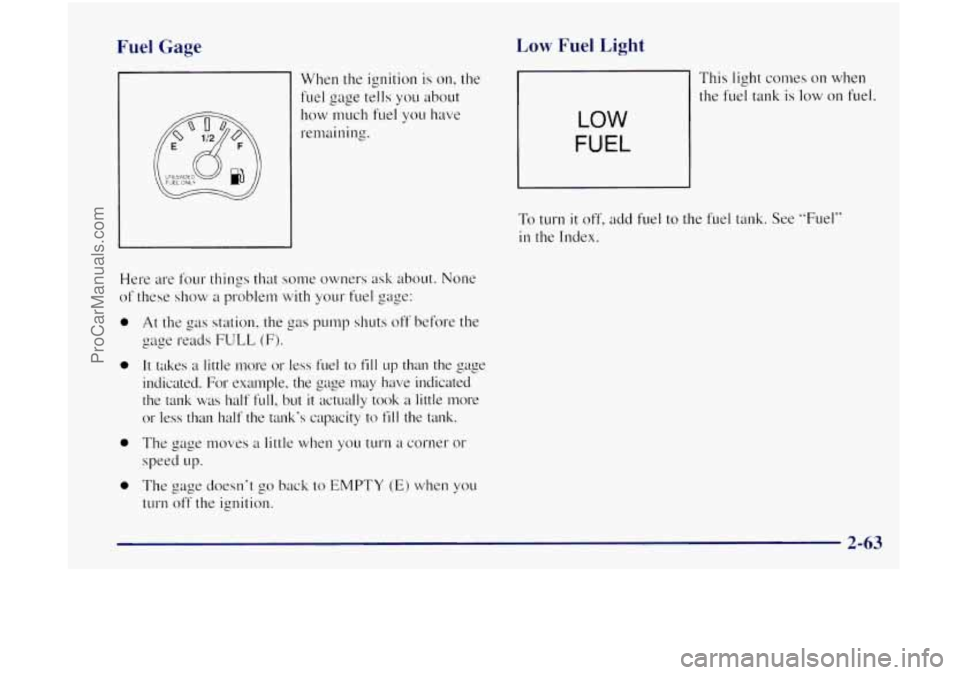
Fuel Gage
@ FUEL ONLY
When the ignition is on, the
fuel gage tells you about
how much fuel you have
remaining.
Here are four things
that some owners ask about. None
of these show
a problem with your fuel gage:
0
0
0
0
At the gas station, the gas pump shuts off before the
gage reads
FULL (F).
It takes a little more or less fuel to fill up than the gage
indicated. For example, the gage may have indicated
the tank was half
full, but it actually took a little more
or less than half the tank’s capacity to
fill the tank.
The gage moves
a little when you turn a corner or
speed up.
The gage doesn‘t
go back to EMPTY (E) when yo11
turn off the ignition.
LOW
FUEL
ow Fuel Light
This light comes on when
the fuel tank is low on fuel.
I I
To turn it off, add fuel to the fuel tank. See “Fuel”
in the Index.
24- -
ProCarManuals.com
Page 194 of 380
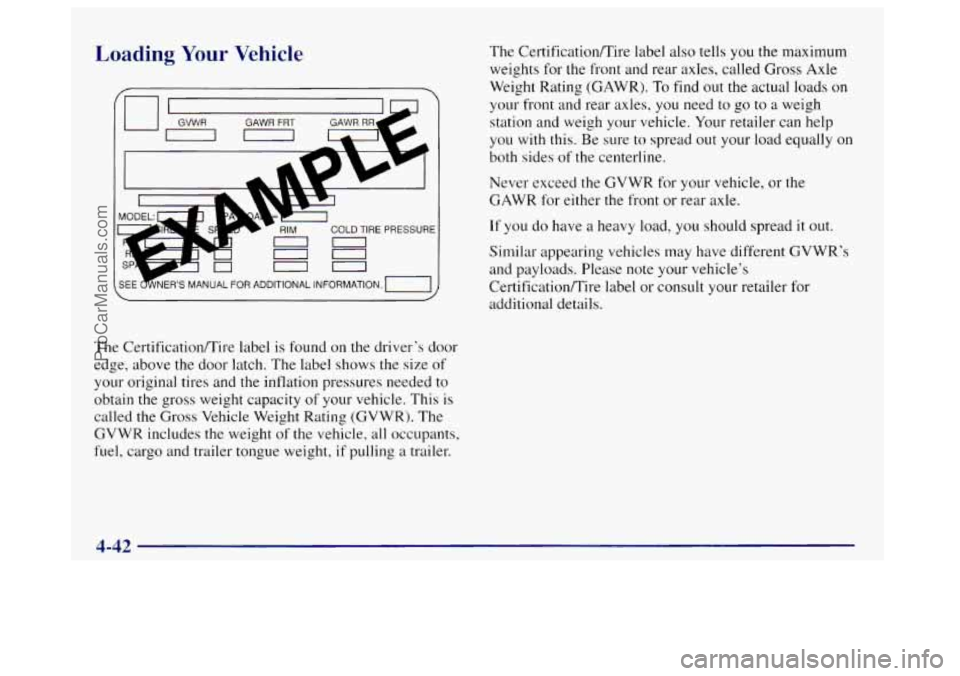
Loading Your Vehicle
The Certificationnire label is found on the driver’s door
edge, above the door latch. The label shows the size of
your original tires and the inflation pressures needed to
obtain the gross weight capacity of your vehicle. This is
called the Gross Vehicle Weight Rating (GVWR). The
GVWR includes the weight
of the vehicle, all occupants,
fuel, cargo and trailer tongue weight,
if pulling a trailer. The
Certificatioflire label also tells you the maximum
weights for the front and rear axles, called Gross Axle
Weight Rating (GAWR).
To find out the actual loads on
your front and rear axles, you need to go to a weigh
station and weigh your vehicle. Your retailer can help
you with this. Be sure to spread out your load equally on
both sides of the centerline.
Never exceed the GVWR
for your vehicle, or the
GAWR for either the front
or rear axle.
If you do have a heavy load, you should spread it out.
Similar appearing vehicles may have different GVWR’s
and payloads. Please note your vehicle’s
CertificationITire label or consult your retailer for
additional details.
ProCarManuals.com
Page 243 of 380
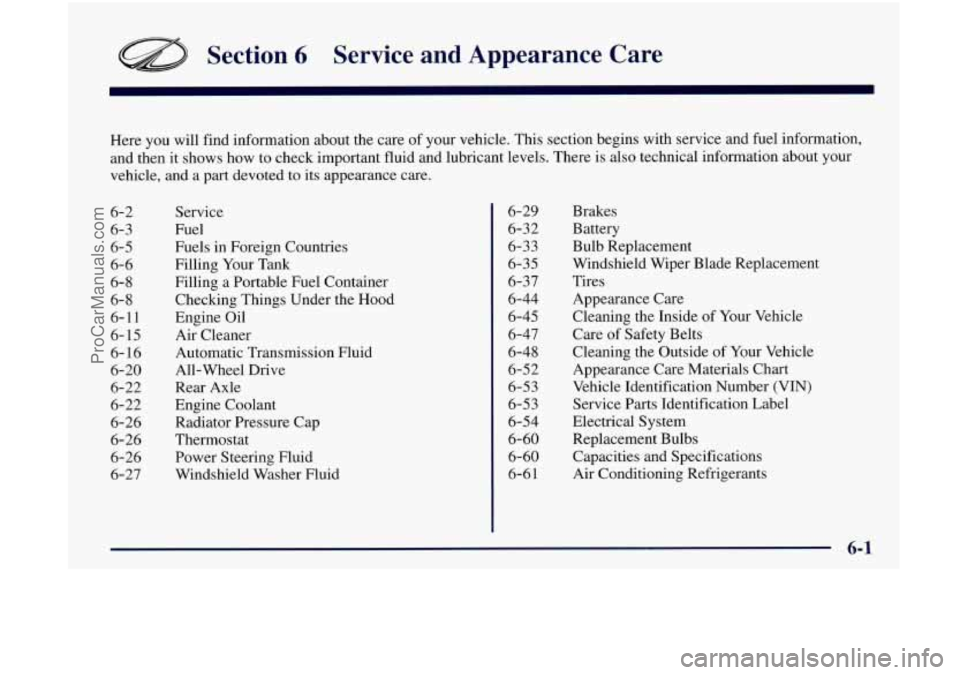
Section 6 Service and Appearance Care
Here you will find information about the care of your vehicle. This section begins with service and fuel information,
and then it shows how to check important fluid and lubricant levels. There is also t\
echnical information about your
vehicle, and a part devoted to its appearance care.
6-2
6- 3
6-5
6-6
6-8
6-8
6-11
6- 15
6- 16
6-20
6-22
6-22
6-26
6-26
6-26 6-27 Service
Fuel
Fuels in Foreign Countries
Filling Your Tank
Filling a Portable Fuel Container
Checking Things Under the
Hood
Engine Oil
Air Cleaner
Automatic Transmission Fluid
All-Wheel Drive
Rear Axle
Engine Coolant Radiator Pressure Cap
Thermostat
Power Steering Fluid
Windshield Washer Fluid
6-29
6-32
6-33
6-35
6-37
6-44
6-45
6-47
6-48
6-52
6-53
6-53
6-54
6-60 6-60
6-6
1
Brakes
Battery
Bulb Replacement
Windshield Wiper Blade Replacement
Tires Appearance Care
Cleaning the Inside of Your Vehicle
Care
of Safety Belts
Cleaning the Outside of Your Vehicle
Appearance Care Materials Chart
Vehicle Identification Number (VIN)
Service Parts Identification Label
Electrical System
Replacement Bulbs
Capacities and Specifications
Air Conditioning Refrigerants
ProCarManuals.com
Page 248 of 380
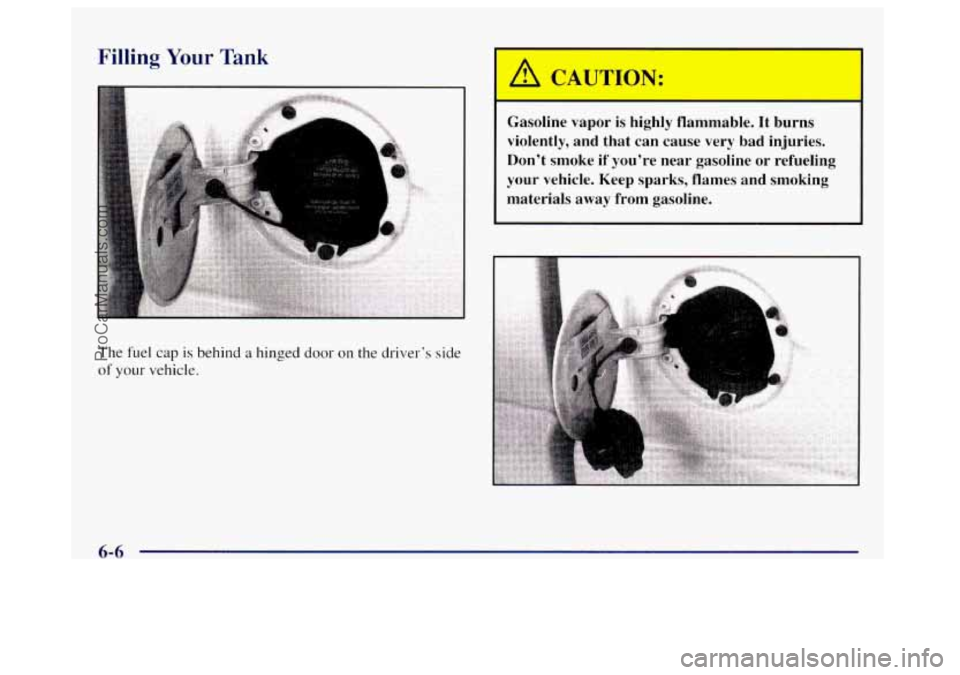
Filling Your Tank
The fuel cap is behind a hinged door on the driver’s side
of your vehicle.
Gasoline vapor is highly flammable. It burns
violently, and that can cause very bad injuries.
Don’t smoke if you’re near gasoline or refueling
your vehicle. Keep sparks, flames and smoking
materials away from gasoline.
6-6
ProCarManuals.com
Page 249 of 380

While refueling, hang the cap by the tether from the
hook
on the filler door.
To remove the cap, turn it slowly to the left
(counterclockwise). The cap has a spring
in it; if you let
L go of the cap too soon, it will spring back to the right.
Y If you get gasoline on yourself and then
something ignites it, you could be badly burned.
Gasoline can spray out on you
if you open the
fuel filler cap too quickly. This spray can happen
if‘ your tank is nearly full, and is more likely in
hot weather. Open the fuel filler cap slowly and
wait for any “hiss” noise to stop. Then unscrew
the cap
all the wav.
Be careful not to spill gasoline. Clean gasoline from
painted surfaces
as soon as possible. See “Cleaning the
Outside
of Your Vehicle” in the Index. When
you put the
cap back on, turn it to the right
(clockwise)
until you hear a clicking sound. Make sure
you
filly install the cap. The diagnostic system can
determine
if the fuel cap has been left off or improperly
installed.
This would allow fuel to evaporate into the
atmosphere. See “Malfunction Indicator Lamp” in the
Index.
NOTICE:
If you need a new cap, be sure to get the right
type. Your retailer can get one for you. If you get
the wrong type, it may not fit properly. This may
cause your malfunction indicator lamp to light
and your fuel tank and emissions system may be
damaged. See “Malfunction Indicator Lamp” in
the Index.
ProCarManuals.com
Page 253 of 380
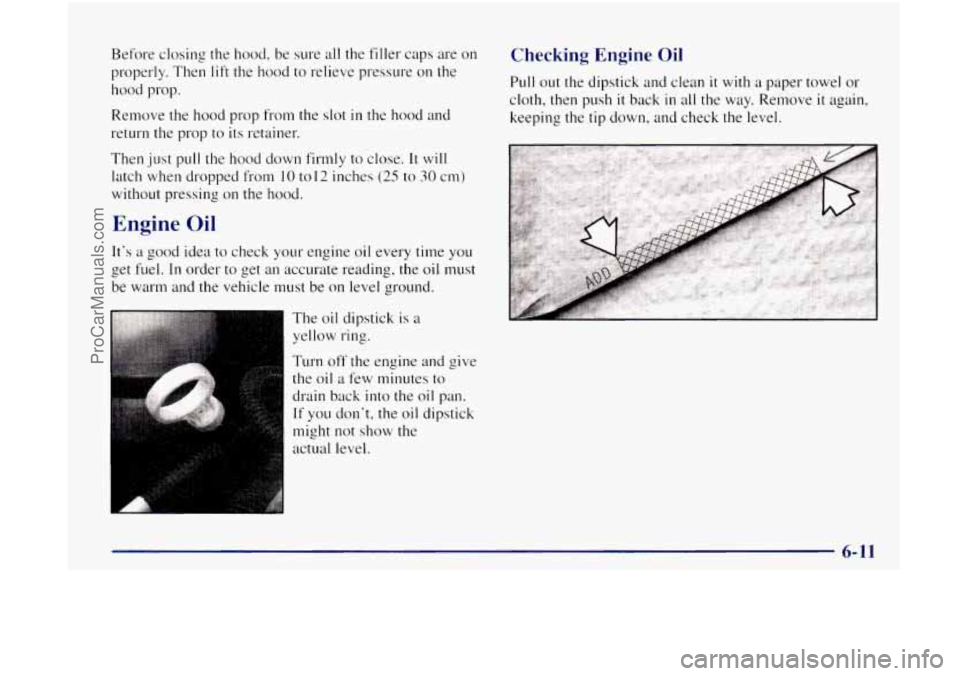
Before closing the hood, be sure all the filler caps are on
properly. Then
lift the hood to relieve pressure on the
hood prop.
Remove the hood
prop from the slot in the hood and
return the prop to its retainer.
Then just pull the hood down firmly to close.
It will
latch when dropped from
10 to 12 inches (25 to 30 cm)
without pressing on the hood.
Engine Oil
It's a good idea to check your engine oil every time you
get fuel.
In order to get an accurate reading, the oil must
be warm and the vehicle must be on level ground.
The
oil dipstick is a
yellow ring.
Turn off the engine and give
the oil
a few minutes to
drain back into the oil pan.
If you don't, the oil dipstick
might not show the
actual level.
Checking Engine Oil
Pull out the dipstick and clean it with a paper towel or
cloth, then push
it back in all the way. Remove it again,
keeping the
tip down, and check the level.
ProCarManuals.com
Page 280 of 380
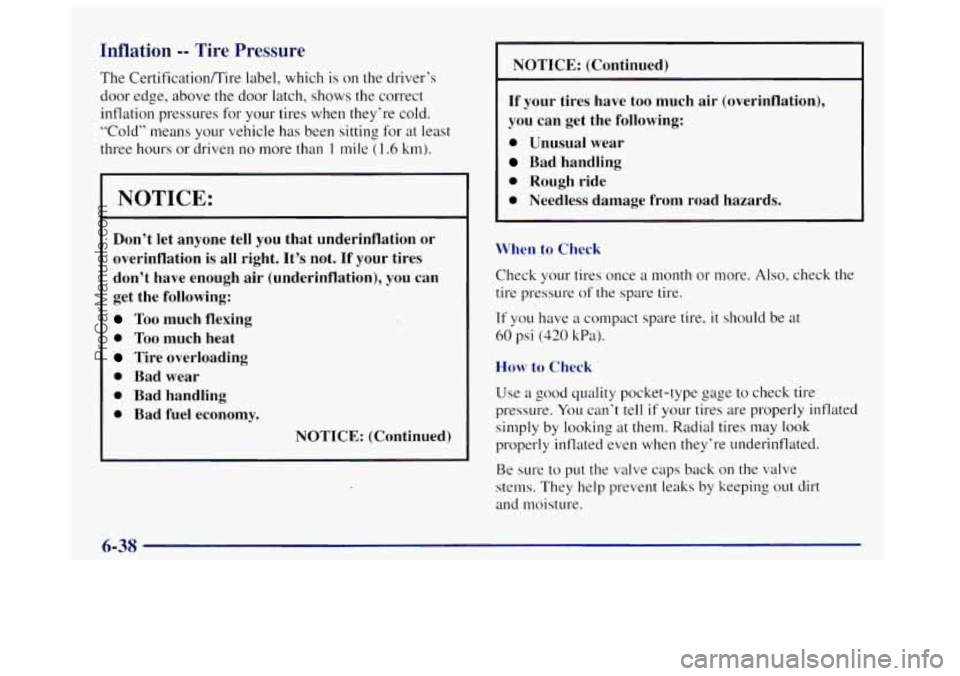
Inflation -- Tire Pressure
The CertificatiodTire label, which is on the driver’s
door edge, above the door latch, shows the correct
inflation pressures for your tires
when they’re cold.
“Cold” means your vehicle has been sitting for
at least
three hours or driven no more than
1 mile (I .6 km).
NOTICE:
Don’t let anyone tell you that underinflation or
overinflation is all right. It’s not. If your tires
don’t have enough air (underinflation), you can
get the following:
Too much flexing
0 Too much heat
Tire overloading
0 Bad wear
0 Bad handling
0 Bad fuel economy.
NOTICE: (Continued)
I NOTICE: (Continued) I
If your tires have too much air (overinflation),
you can get the following:
0 Unusual wear
Bad handling
0 Rough ride
0 Needless damage from road hazards.
When to Check
Check your tires once a month or more. Also, check the
tire pressure
of the spare tire.
If you have a compact spare tire, it should be at
60 psi (420 kPa).
How to Check
Use a good quality pocket-type gage to check tire
pressure.
You can’t tell if your tires are properly inflated
simply by looking at them. Radial tires may
look
properly inflated even when they’re underinflated.
Be sure to put the valve
caps back on the valve
stems. They help prevent leaks
by keeping out dirt
and moisture.
6-38
ProCarManuals.com
Page 302 of 380
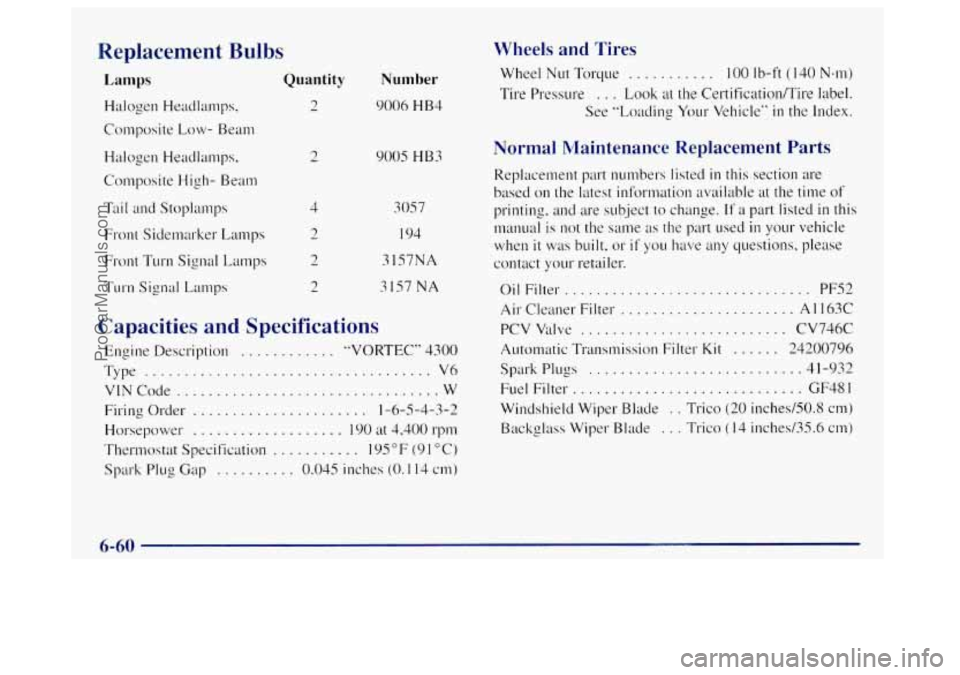
Replacement Bulbs
Lamps
Halogen Headlamps,
Composite Low- Beam
Halogen Headlamps.
Composite High- Beam
Tail and Stoplamps
Front Sidemarker Lamps
Front Turn Signal Lamps
Turn Signal Lamps
Quantity
2
2
4
Number
9006 HB4
9005 HB3
305 7
I94
31S7NA
3157
NA
Capacities and Specifications
Engine Description ............ "VORTEC" 4300
Type
.................................... V6
VINCode ................................. W
Firing Order
...................... 1-6-5-4-3-2
Horsepower
................... I90 at 4,400 rpm
Thermostat Specification
........... 1% "F (9 1 "C)
Spark Plug Gap
.......... 0.045 inches (0. I 14 cm)
Wheels and Tires
Wheel Nut Torque ........... 100 Ib-ft ( I40 Nem)
Tire Pressure . , . Look at the Certification/Tire label.
See "Loading Your Vehicle"
in the Index.
Normal Maintenance Replacement Parts
Replacement part numbers listed in this section are
based on the latest information available at the time
of
printing, and are subject to change. If a part listed in this
manual is not the same
as the part used in your vehicle
when
it was built, or if you have any questions, please
contact your retailer.
Oil Filter.
.............................. PFS2
Air Cleaner Filter ...................... A 1 163C
PCV Valve .......................... CV746C
Automatic Transmission Filter
Kit ...... 24200796
Spark P~LI~S
........................... 4 1-932
Fuel Filter ............................. GF48 1
Windshield Wiper Blade . . Trico (20 inchedS0.S crn)
Backglass Wiper Blade
... Trico (14 inched35.6 cm)
6-60
ProCarManuals.com
Page 303 of 380
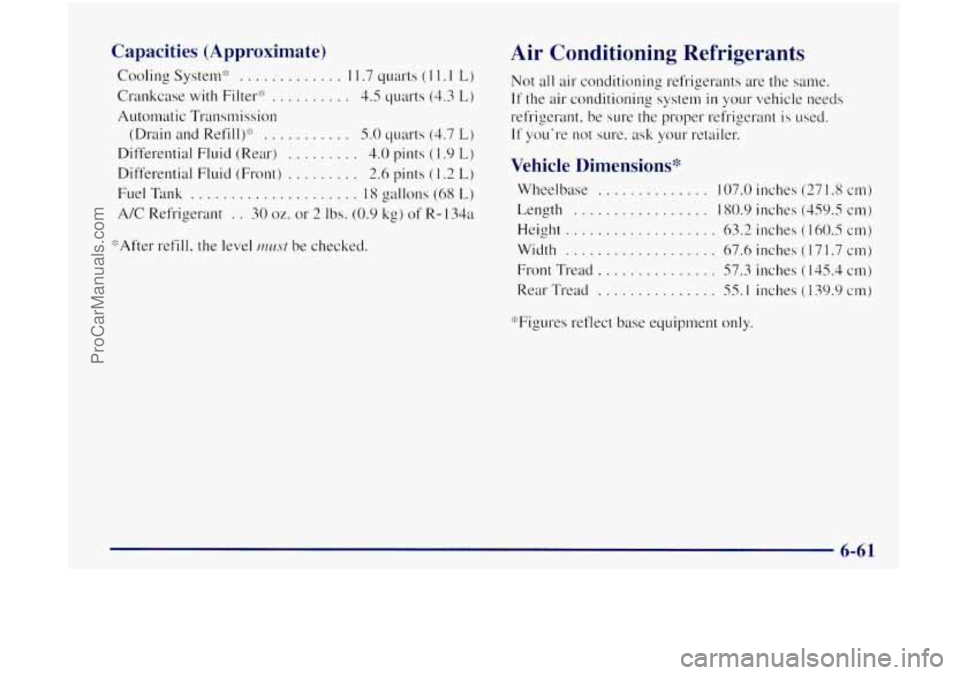
Capacities (Approximat-e)
Cooling System'" ............. 1 1.7 quarts (1 I, I L)
Crankcase with Filter'" .......... 4.5 quarts (4.3 L)
Automatic Transmission
(Drain and Refill):':
........... 5.0 quarts (4.7 L)
Differential Fluid (Rear) ......... 4.0 pints ( I .9 L)
Differential Fluid (Front) ......... 2.6 pints ( 1.2 L)
Fuel Tank ..................... 18 gallons (68 L)
A/C Refrigerant . . 30 oz. or 2 Ibs. (0.9 kg) of R- 13421
'"After refill, the level
m~st be checked.
Air Conditioning Refrigerants
Not all air conditioning refrigerants are the same.
If the air conditioning system in your vehicle needs
refrigerant. be
SLIE the proper refrigerant is sed.
I1 you're not sure. ask your retailer.
Vehicle Dimensions*
Wheelbase .............. 107.0 inches (27 1.8 cm)
Length ................. 180.9 inches (459.5 cm)
Height
................... 63.2 inches ( 160.5 cm)
Width ................... 67.6 inches ( 17 1.7 an)
Front Tread
............... 57.3 inches ( 145.4 cm)
Rear Tread ............... 55.1 inches ( 139.9 cm)
'"Figures reflect base equipment only.
6-61
ProCarManuals.com